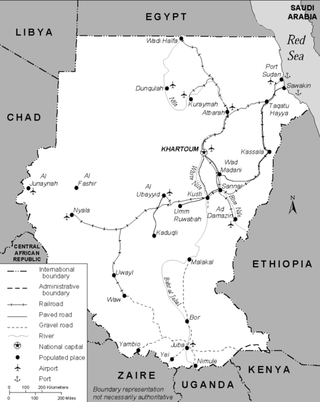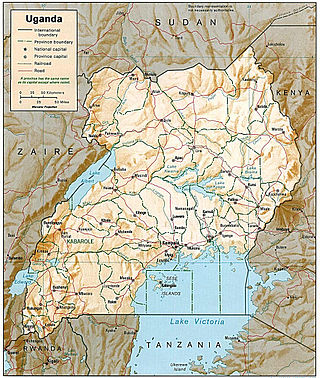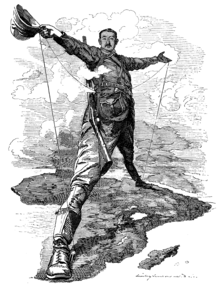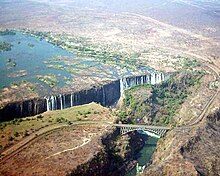
The Nile is a major north-flowing river in northeastern Africa. It flows into the Mediterranean Sea. The Nile is the longest river in Africa and has historically been considered the longest river in the world, though this has been contested by research suggesting that the Amazon River is slightly longer. Of the world's major rivers, the Nile is one of the smallest, as measured by annual flow in cubic metres of water. About 6,650 km (4,130 mi) long, its drainage basin covers eleven countries: the Democratic Republic of the Congo, Tanzania, Burundi, Rwanda, Uganda, Kenya, Ethiopia, Eritrea, South Sudan, Sudan, and Egypt. In particular, the Nile is the primary water source of Egypt, Sudan and South Sudan. Additionally, the Nile is an important economic river, supporting agriculture and fishing.

Transport in Sudan during the early 1990s included an extensive railroad system that served the more important populated areas except in the far south, a meager road network, a natural inland waterway—the Nile River and its tributaries—and a national airline that provided both international and domestic service. Complementing this infrastructure was Port Sudan, a major deep-water port on the Red Sea, and a small but modern national merchant marine. Additionally, a pipeline transporting petroleum products extended from the port to Khartoum.

Transport in Uganda refers to the transportation structure in Uganda. The country has an extensive network of paved and unpaved roads.

Wādī Ḥalfā is a city in the Northern state of Sudan on the shores of Lake Nubia near the border with Egypt. It is the terminus of a rail line from Khartoum and the point where goods are transferred from rail to ferries going down the lake. As of 2007, the city had a population of 15,725. The city is located amidst numerous ancient Nubian antiquities and was the focus of much archaeological work by teams seeking to save artifacts from the flooding caused by the completion of the Aswan Dam.

Zambia Railways (ZR) is the national railway company of Zambia, one of the two major railway organisations in Zambia. The other system is the binational TAZARA Railway (TAZARA) that interconnects with the ZR at Kapiri Mposhi and provides a link to the Tanzanian port of Dar es Salaam.
The Sudan Military Railway was a military railway constructed from Wadi Halfa to Abu Hamed in 1896 and 1897 by Sirdar Horatio Kitchener in order to supply the Anglo-Egyptian army taking part in the Mahdist War. It was the predecessor line for the present-day Sudan Railway.

Railway stations in Sudan include:
Railway stations in Uganda include:

Sudan has 4,725 kilometers of narrow-gauge, single-track railways. The main line runs from Wadi Halfa on the Egyptian border to Khartoum and southwest to El-Obeid via Sennar and Kosti, with extensions to Nyala in Southern Darfur and Wau in Western Bahr al Ghazal, South Sudan. Other lines connect Atbara and Sennar with Port Sudan, and Sennar with Ad-Damazin. A 1,400-kilometer line serves the Al Jazirah cotton-growing region. There are plans to rehabilitate rail transport to reverse decades of neglect and declining efficiency. Service on some lines may be interrupted during the rainy season.

The Cairo–Cape Town Highway is Trans-African Highway 4 in the transcontinental road network being developed by the United Nations Economic Commission for Africa (UNECA), the African Development Bank (AfDB), and the African Union. The route has a length of 10,228 km (6,355 mi) and links Cairo in Egypt to Cape Town in South Africa.

All railway stations in South Sudan are on the Babonasa-Wau line, which was built from 1959 to 1962. During the Second Sudanese Civil War, the line was badly damaged and parts of the line were mined. It was fully restored in 2010 with funding of $250 million from United Nations.

South Sudan does not have an extensive rail system. Current rail infrastructure, which was constructed between 1959–1962, and was left over from the previous Sudan government is in a serious state of disrepair. It consists of a 248 kilometers (154 mi) narrow-gauge, single-track line that connects Babonosa (Sudan) with the city of Wau in South Sudan. The line was left in poor condition after the Second Sudanese Civil War after several parts of it were mined; the line was fully rehabilitated with United Nations funds.

Narrow-gauge railways are common in Africa, where great distances, challenging terrain and low cost have made the narrow gauges attractive. Many nations, particularly in Southern Africa, including the extensive South African Railway network (Spoornet), use a 3 ft 6 in gauge. Metre gauge is also common, as in the case of the Uganda Railway. There used to be extensive 2 ft and 600 mm gauge networks in countries such as Morocco, Congo, Angola, Namibia and South Africa, but these have mostly been dismantled or converted. Some also survive in Egypt: in the countryside around Luxor, narrow-gauge railways are used for the transportation of sugar cane.
Egypt–Sudan Railway Committee (ESRC) is a multinational committee that was created in 2008 to promote railway connecting lines between Egypt and Sudan.

The Suakin-Berber railway on the Red Sea coastal region in Sudan was a short-lived military project that never reached completion. Its construction began in February 1885, being intended to provide a connection between Berber on the River Nile and Suakin on the Red Sea littoral for the rapid deployment of troops and military equipment in Britain’s involvement in the Mahdist war.
Stella Maud Court Treatt, FRGS was a South African filmmaker, author, and adventurer who with her first husband Chaplin Court Treatt undertook the Court Treatt Expedition 1924–1926, the first successful attempt to drive a motor car from Cape Town to Cairo.
Babanusa-Wau Railway is an international railway line from the town of Babanusa in Sudan to South Sudan's second largest city Wau. It terminates at Wau Railway Station. The 1,067 mm gauge railway line is 445.5 km long. 195.5 km are running on Sudanese territory, 250 km on South Sudanese territory. The South Sudanese section of the railway line is currently the only railway in South Sudan.
The Kenya Standard Gauge Railway (SGR) is a partially fnished railway system connecting Kenya's cities. Once completed, it will link the country to the neighboring country of Uganda, and through Uganda, to South Sudan, the Democratic Republic of the Congo, Rwanda, and Burundi. There are also plans to link to Addis Ababa, in neighboring Ethiopia to the north. The first segment, between Mombasa and Nairobi, opened passenger rail service in June 2017, and freight rail service in January 2018. Other segments are under construction or planned. The new standard gauge railway, is intended to replace the old, inefficient metre-gauge railway system.














